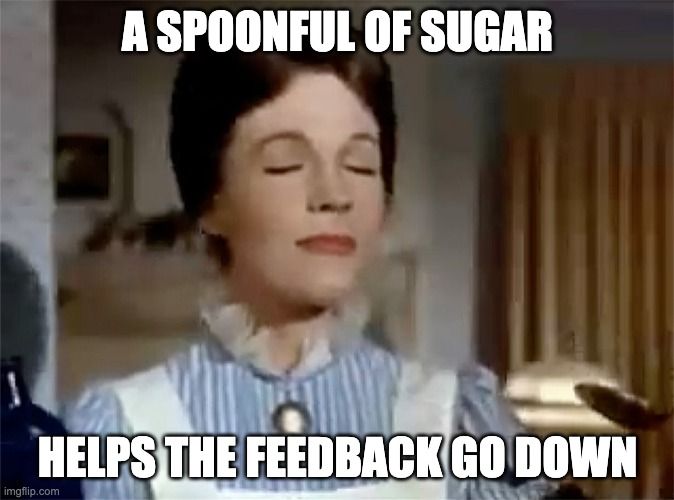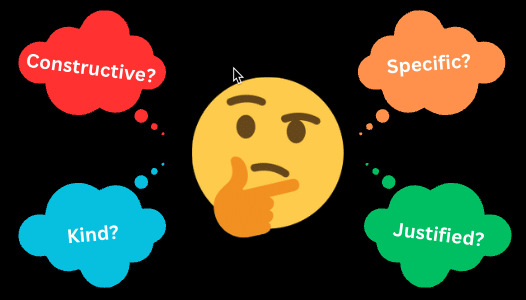Have you ever had to give feedback to someone at work? It can be scary!
What do you say? How do you get your point across without offending your coworker?

By wording your feedback so that it's constructive, specific, justified, and kind, it's more likely to be heard, understood, and accepted.
Example: Joe's Presentation
Once, my coworker, Joe, gave a presentation that didn’t go very well.

He asked me how I thought it went.

I couldn’t say, “Your presentation was terrible! Everyone was bored.”
So what could I say to help him?

Using the 4 characteristics of good feedback helped me craft a helpful response to Joe!
1. Constructive Feedback
Constructive feedback is advice meant for support. Use it to help your coworkers identify solutions to problems.
Destructive feedback is focused on faults. Your coworkers might take it as a personal attack.
Feedback that is constructive, instead of destructive, allows the receiver to accept it without judgment.

Example
Instead of telling Joe, “The middle of your presentation was boring.”

Try saying, “The beginning of your presentation was interesting because the graphics communicated your point well.”

This gives Joe a positive start to work from.
2. Specific Feedback
Vague feedback is usually not useful.

Feedback should be specific so the receiver understands what they need to change.
Example
Instead of telling Joe, “The middle of your presentation was boring.”

Try saying, “The middle of your presentation could use an activity or discussion.”

This gives Joe a specific way to improve his presentation.
3. Justified Feedback
Communicate the reason for the feedback.

Feedback justified by data and/or personal experience tells the receiver why you're suggesting a change.
Example
Instead of telling Joe, “The middle of your presentation was boring.”

Try saying, “The middle of your presentation could use an activity or discussion to engage the audience.”

This gives Joe a reason to change his presentation.
4. Kind Feedback
The easiest way to get someone to hear your point of view is to make sure they feel safe.

Kind feedback lets the receiver know that you're not attacking them — you're trying to help!

Example
Instead of telling Joe, “The middle of your presentation was boring.”
 Photo by whoislimos on Unsplash
Photo by whoislimos on UnsplashTry saying, “I’d be happy to help you brainstorm some ideas for activities.”

That way, Joe knows that you're trying to help him!
Quiz
Let's help someone else! Another coworker, Dani, asks you to review a draft of an e-mail she has written. You find several misspelled words. What is the best feedback you can give her? Select all that apply.
Summary
Your feedback to Joe has changed from:
“Your presentation was terrible! Everyone was bored...”

to...
“The beginning of your presentation was interesting because the graphics communicated your point well."

"The middle of your presentation could use an activity or discussion to engage the audience."

"I’d be happy to help you brainstorm some ideas for activities.”

Joe says, "Thank you! You've given me a lot to think about. I'd love your help!"

Practice
Let's try another situation:
You work at a grocery store as a cashier.
Your coworker, Madison, just told you, "You work way too slowly, and we're busy!"
 Photo by Adrien Delforge on Unsplash
Photo by Adrien Delforge on UnsplashWhat's the best way for them to re-word their feedback?
A. "I see that your line is backing up quite a bit. How can I help?"
B. "Just aim the bar code at the scanner, and it should register faster."
C. "It's not that hard, just throw the groceries in the bag!"
D. Their feedback is fine as-is.
Quiz
Choose the best answer.
Take Action

Think about how can you apply the 4 characteristics of good feedback to…
Your feedback matters to us.
This Byte helped me better understand the topic.
